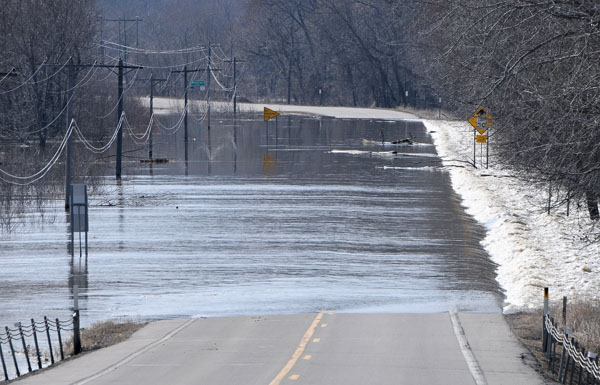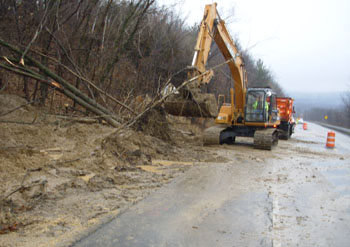By Chris Joyce

The Minnesota River submerges Hwy 19 near Henderson. Photo by David Gonzalez |
Ice jams and overflowing river basins forced the closing of several roads and bridges across the state during the past week.
The Hwy 10 bridge over the Mississippi River at the Little Falls bypass was closed March 17 due to strong currents that caused an ice jam in the main channel and erosion to the bridge.
District 3 crews monitored the ice jam, which consisted of “massive ice chunks, six to 10 feet high in some places,” according to Gary Dirlam, assistant district engineer for maintenance operations.
Repair work to the bridge began March 20 under an Emergency Order. Crews from Lunda Construction are in the process of stabilizing the westbound lanes, removing the approach panels and assessing damage to the bridge.
Dirlam expects the westbound lanes to be re-opened by this weekend. The bridge will carry a single lane of Hwy 10 traffic in each direction. Crews will then begin replacing the eastbound portion of the bridge.
“Many people have been working very long hours on this,” he said, noting that, ironically, District 3 had been preparing to send crews to help in Moorhead or Montevideo before the Hwy 10 bridge incident.
“It’s been an all-out effort,” he said.
While the waters appear to be receding in some places, flood conditions continue to affect nearly half the counties in the state.
The Stillwater Lift bridge over the St. Croix River closed March 23. The lift span was raised seven feet and will be kept in this position until the bridge is re-opened. Crews placed concrete barriers on the bridge to weigh it down and protect it from floating debris. Metro District bridge crews will monitor conditions around-the-clock.
Other Twin Cities roads affected by flooding include Hwy 41, Hwy 101 and Interstate 35W in the southwest metro area.
In St. Paul, one runway at the downtown airport was closed March 24 and a taxiway is expected to close March 25 to test the pavement for saturation. However, the airport is not flooded and is operational, according to Dan McDowell, Aeronautics public affairs coordinator. The closures were expected to last less than 24 hours.
Strong winds pushed chunks of ice from Lac Qui Parle Lake on to the westbound lane of Hwy 40 west of Milan, creating hazardous driving conditions March 23, said Diane Beck, Willmar/District 8 public affairs coordinator. Plows were brought in to remove the ice and by the next day the driving lanes were clear.
Along the North Dakota border, in the Red River basin, segments of Hwy 1, Hwy 11, Hwy 75, Hwy 175, Hwy 220 and Hwy 317 are closed, according to Karen Bedeau, Bemidji/District 2 public affairs coordinator. In addition, the Sorlie Bridge on U.S. Hwy 2 business route in East Grand Forks is closed.
In the Detroit Lakes district, Hwy 12 east of Ortonville is closed between Hwy 75 and Big Stone County Road 21, reported Dana Hanson, District 4 public affairs coordinator. Hwy 75 near Kent re-opened to traffic March 24 after being closed for several days because of flooding.
Along the Minnesota River basin, Mn/DOT and the State Patrol also closed several roads, including segments of Hwy 14, Hwy 19, Hwy 93 and the Hwy 99 bridge in St. Peter, according to Rebecca Arndt, Mankato/District 7 public affairs coordinator.
To view more photos of the floods, visit http://www.dot.state.mn.us/flood/MNflood2010/index.html.

Mn/DOT crews work to remove debris from Hwy 8 near Taylors Falls after a mudslide dumped loads of rock, mud and trees on to the road. Photo by Dave Hagle
|
Rain, fast-melting snow cause mudslides on Highway 8
By Beth Petrowske
A mudslide just south of Taylors Falls closed one lane of traffic on Hwy 8 from 6:15 p.m. to 9:25 p.m., March 11. Flaggers directed motorists through the open lane while maintenance crews removed debris from the road.
Concerned about the possibility of another mudslide, crews monitored the area throughout the night. As feared, a second mudslide occurred sometime around midnight. The area was cordoned off early the next morning as crews worked to remove more mud, rocks and fallen trees from the highway.
“It had rained for four days, plus the snow was melting so fast that the hillside became extremely unstable — that’s what caused the mudslides,” said Dave Hagle, Metro maintenance supervisor. “After removing all of the debris from the road, we secured the bottom of the hill with riprap so it wouldn’t slide any further.” |



